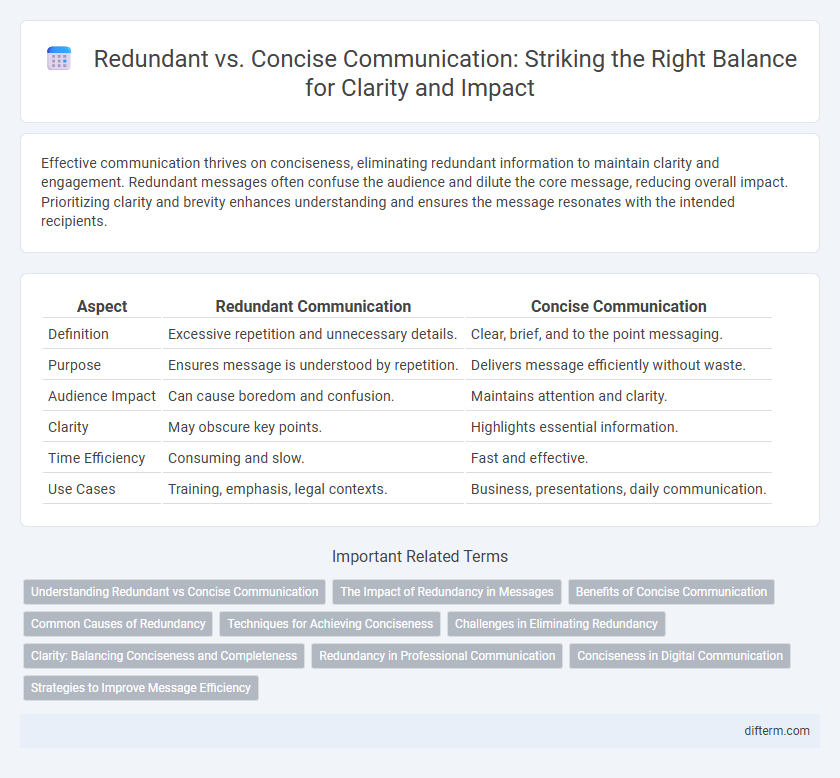Effective communication thrives on conciseness, eliminating redundant information to maintain clarity and engagement. Redundant messages often confuse the audience and dilute the core message, reducing overall impact. Prioritizing clarity and brevity enhances understanding and ensures the message resonates with the intended recipients.
Table of Comparison
| Aspect | Redundant Communication | Concise Communication |
|---|---|---|
| Definition | Excessive repetition and unnecessary details. | Clear, brief, and to the point messaging. |
| Purpose | Ensures message is understood by repetition. | Delivers message efficiently without waste. |
| Audience Impact | Can cause boredom and confusion. | Maintains attention and clarity. |
| Clarity | May obscure key points. | Highlights essential information. |
| Time Efficiency | Consuming and slow. | Fast and effective. |
| Use Cases | Training, emphasis, legal contexts. | Business, presentations, daily communication. |
Understanding Redundant vs Concise Communication
Redundant communication involves repeating information unnecessarily, which can lead to confusion and reduced efficiency in message delivery. Concise communication emphasizes clarity and brevity, ensuring that the core message is understood quickly and accurately. Effective understanding of these styles improves interpersonal and organizational communication by minimizing misunderstandings and enhancing information retention.
The Impact of Redundancy in Messages
Redundancy in communication often leads to message dilution, causing recipients to lose focus and decreasing overall comprehension. Studies show that concise messages improve information retention by up to 50%, highlighting the importance of eliminating unnecessary repetitions. Effective communication prioritizes clarity and brevity to ensure the core message is understood quickly and accurately.
Benefits of Concise Communication
Concise communication reduces information overload, enabling faster decision-making and improved clarity in professional settings. By eliminating redundancy, messages become more impactful and easier to retain, which enhances overall productivity and engagement. This streamlined approach minimizes misunderstandings and fosters efficient collaboration across teams.
Common Causes of Redundancy
Redundancy in communication often arises from the overuse of repetitive words, unnecessary filler phrases, and an excessive reliance on jargon that complicates the message. Common causes include lack of clarity in thought, fear of misunderstanding, and attempts to sound more formal or authoritative. Eliminating redundancy improves clarity, enhances audience engagement, and ensures the message is delivered efficiently.
Techniques for Achieving Conciseness
Techniques for achieving conciseness in communication include eliminating redundant words, using precise vocabulary, and structuring sentences to convey maximum meaning with minimal text. Employing active voice and avoiding filler phrases further enhances clarity and brevity. These methods improve message impact by reducing cognitive load and ensuring key points are easily understood.
Challenges in Eliminating Redundancy
Eliminating redundancy in communication faces challenges such as deeply ingrained habits, where individuals repeat information for clarity or emphasis, leading to overcommunication. Diverse audiences require varied levels of detail, forcing communicators to balance thoroughness with brevity to avoid misinterpretation. Technology and automated messages often generate unnecessary repetition, complicating efforts to present concise, precise information.
Clarity: Balancing Conciseness and Completeness
Effective communication demands a balance between conciseness and completeness to ensure clarity. Redundant information can obscure key messages and overwhelm the audience, while overly concise communication may omit critical details necessary for understanding. Prioritizing clear, precise language that conveys essential points without unnecessary repetition enhances comprehension and engagement.
Redundancy in Professional Communication
Redundancy in professional communication often leads to inefficiency by repeating information unnecessarily, which can dilute the main message and waste valuable time. Excessive redundancy increases the risk of misunderstandings as audiences may become disengaged or overlook critical details. Streamlining communication with precise language enhances clarity, promotes better decision-making, and improves overall workplace productivity.
Conciseness in Digital Communication
Conciseness in digital communication enhances clarity by eliminating redundant information and focusing on essential points, which improves message retention and reduces reader fatigue. Employing precise language and structured formatting ensures that recipients quickly grasp key ideas, increasing the effectiveness of emails, chats, and social media posts. Optimized brevity supports faster decision-making and boosts overall communication efficiency in digital environments.
Strategies to Improve Message Efficiency
Using concise language enhances message clarity by eliminating redundant words and phrases that dilute the core meaning. Implementing strategies such as active voice, precise vocabulary, and structured formatting improves comprehension and retention. Consistent feedback loops and audience analysis further refine communication efficiency and reduce unnecessary repetition.
redundant vs concise Infographic

 difterm.com
difterm.com